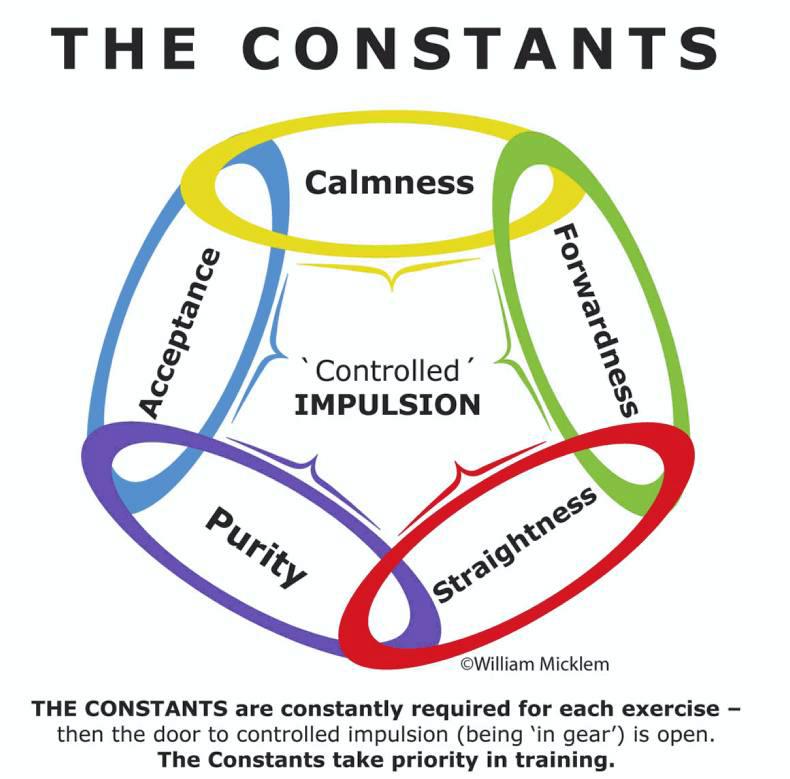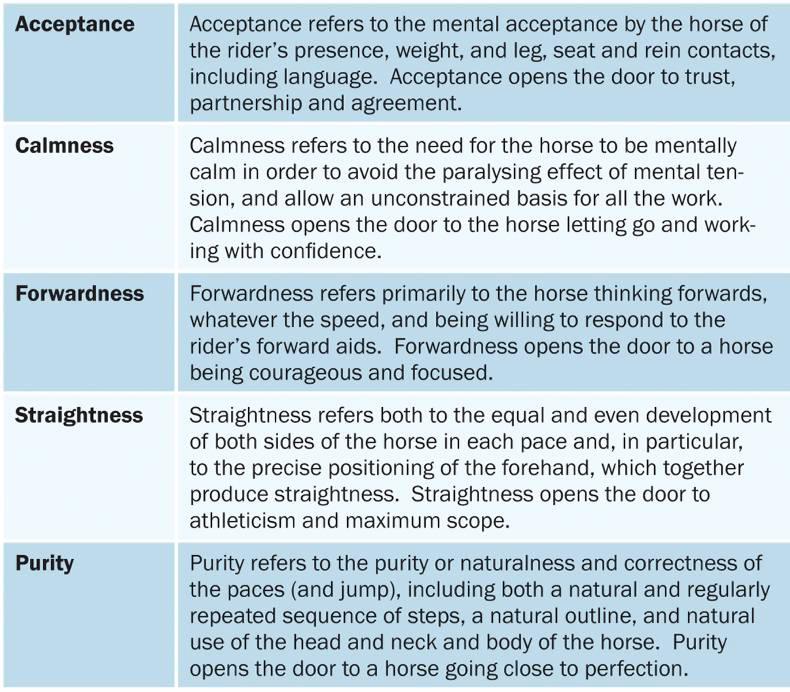A good idea has to give way to a better idea. It happens every day in some way. It is the way of the world.
It was what stimulated me to invent the Micklem bridle, and about 30 years ago led me to put together the training structure that I call the Constants and Variables.
There are five CONSTANTS, so called because they are all constantly required, and five VARIABLES, which are all required in varying amounts and ways according to the individual needs of each progressive exercise being used.
It is a structure and recipe that works for all levels of riding and training. It owes much to those two great coaches, Jack Le Goff and Bert de Nemethy, and there are also some connections to the German Scales of Training, but it is simpler, more memorable, and less open to varying interpretations.
At the heart of the five Constants are what I call the three musketeers, CALMNESS, FORWARDNESS and STRAIGHTNESS, and to these are added ACCEPTANCE and PURITY to make a circle of strength.


Acceptance
The meaning of Calmness, Forwardness and Straightness is fairly obvious, but ‘submission’ is the term more normally used instead of acceptance. I use the term acceptance because there is an important distinction between the two words. Acceptance leads to trust, partnership and agreement, and requires that the horse understands what is required, while submission produces an unquestioning follower. The difference between acceptance and submission is the difference between a horse that knows he could react differently but chooses not to, and a horse that knows there is no other option.
Practice makes permanent not perfect
Purity
I use the word purity to encapsulate not just the rhythm and regularity but also the natural paces and natural outline of the horse, avoiding anything in the way of going that is unnatural or superfluous. It is the golden thread running through every movement and exercise and refers to the whole way of going in each pace, (what the Germans call Reinheitergange, which translates as purity).
We have to be constantly aware of maintaining the purity of the paces, because physically everything begins and ends with the purity of the paces. As the Portugese dressage maestro Nuno Oliveira said “look for the purity of the three gaits. The rest will follow easily.” (NB: The same applies to the purity of the jump.)
Purity can only be achieved if the horse can use its back … often not easy when a rider is sitting on it. If your horse is stiff or dropped in the back you can use lunging, rising trot and a light seat in canter, combined with simple and easy exercises to allow the back to begin to work. In addition you can make life easier by working in areas where there is already purity.
If the right tempo and regularity of steps exists only in the working trot then this is what you must work in initially, but if your horse has no period of suspension in the canter you only do a minimum of canter to begin with. To do otherwise would run the risk of confirming the fault because practice makes permanent not perfect.
In this way every main exercise you do should develop and improve the purity of the paces, because you will not accept any work where the regularity of the paces or natural outline and way of going is lost.
Acceptance, Calmness & Forwardness together
Acceptance, calmness and forwardness are all primarily mental qualities, and their foundation is understanding, combined with the rider not asking their horse to do things beyond which they are capable.
This is a key point and leads us from the start to reject the mechanical and forced. If you force things then almost certainly the horse will be restricted both mentally and physically.
The beginning and ongoing demand of our daily training journey has to be acceptance, as we ask our horses to accept the varied and what to them must seem the often strange demands of our sport.
If only calmness was required then our horses could stay in the field. Instead we work with each horse, using a solid understanding of the nature of horses and humane, effective methods, progressing a step at a time that allows trust to be developed. Then calmness will go hand in hand with acceptance.
The basis for calmness comes from an environment that is as natural as possible, including equine company and regular steady work. Calmness becomes a habit if the trainer gives the horse sufficient time to settle before progressing with new demands, and is willing to back off and make things easier if tension appears.
It would also be normal to have rest periods during a riding session and keep returning to easy work with an easy rein. In addition lungeing is great for calmness, as is hacking, turning out, being calm yourself, and never abusing the horse’s trust and abilities.
During work each horse has to be very clearly and positively asked and allowed to go forwards, but horses are fundamentally very willing to do this for their riders if they understand what is required, have confidence in their ability and are free of pain. If this were not the case we would never have developed equestrian sports as we know them. As we ask for more forwardness there may be some loss of acceptance and calmness, so a step back is taken.
Equally as you achieve better calmness with slow regular work, it is possible that your horse will become a little backward thinking, so immediately you prioritise forwardness by riding out in company, or cantering with a light seat, or possibly jumping. But probably nothing encourages forwardness more than an enthusiastic rider with a good balance and a soft-allowing rein contact. Then if the calmness is being lost you can once again make the work less exciting. In this way you can gradually progress with both calmness and forwardness.
Therefore there is a continual need for awareness of the changing state of the horse’s mind and, on our part, a willingness to act and react, asking a little more or a little less according to the situation.
Calmness, Forwardness & Straightness together
All levels of horses should be calm forwards and straight, and there is no phrase in equestrian education and literature that is used more frequently than this. They are continually identified as the supreme priorities, and they work as a team.
Calmness without forwardness does not get you off the starting blocks, while forwardness without calmness can lead to speed but never to impulsion. When forwardness is added to the acceptance and calmness the horse will have everything in place that is required for improving the straightness. But straightness in any quadruped is always a rarity and not easy to achieve.
It is initially done by achieving an even bend on both reins in walk and trot and then, as your horse comes between the aids, by beginning a very small degree of shoulder-in (called position to the inside). As control of the positioning of the shoulders is achieved on both reins then straightness on straight lines also becomes possible.
As a horse becomes more advanced and medium paces are introduced they may become a little crooked once again. Then as we work to straighten them it has a tendency to reduce the forwardness. So it is necessary to keep alternating between riding forwards and straightening, until you can ride forwards with a straight horse. This is a process you will repeat often.
But, whatever you do to improve a particular constant you also have to guard the purity. For example it is hugely damaging either to get acceptance by using a gadget that produces an unnatural way of going, or to force straightness and therefore lose the regularity of the steps or the period of suspension. Unfortunately this is a common sight in show jumping.
Controlled impulsion
The five Constants can be established from the beginning even with young horses on the lunge. Then they will all work together to produce what is the gold medal of dressage training, the key ingredient for performance, controlled IMPULSION. Whether it is for dressage, show jumping or cross country we need this controlled impulsion. Another way to say this is that the horse needs to be ‘in gear.’
Lungeing is not an easy skill to do well but it is a great tool to establish the basics so that retraining is not required … and what a huge difference good lungeing can make to the long-term potential of a horse and to their attitude to work.
But beware of lungeing pens because they make a horse crooked as they cling to the outside wall. Horse walkers have the opposite effect, which is good for straightness, as the horse gravitates to the inside wall. Because of this they are naturally ‘position to the inside’.
We need to maintain all the Constants as we work through the beautiful progression of exercises. But the most important point and simply brilliant result of this is that we can keep building controlled impulsion. Quality work requires bags of impulsion, with the horse using the back and working as one connected athletic unit.
However, the other side of this coin is that even if one of the Constants is insufficient good controlled impulsion is simply not possible. Without acceptance it will not be controlled, and without calmness the impulsion is inevitably restricted by the paralysing effect of tension.
Without forwardness impulsion cannot exist, as willingness to go forward is the basis for impulsion, and without straightness impulsion is restricted, as one side of the horse is used less than the other. Finally, without purity the horse does not work naturally, with a natural outline and paces, as one whole connected unit, which is essential for both impulsion and for ‘classical’ and humane training.
We have to continually revisit and guard the constants in the daily training
Warm-up and cool-down
If any of the constants are weak or missing the controlled impulsion immediately deteriorates therefore we have to continually revisit and guard the constants in the daily training.
In every training session you will start by first re-establishing the acceptance, calmness and forwardness in the warm up period, before going on to add and confirm the straightness in the suppling period, before carrying all the constants into your main work as you develop more impulsion and athleticism.

Then this process is carried out in reverse as you cool a horse down and finish with them happy and accepting. The practice of revision and re-establishing the basics is part and parcel of daily horse training, part of a circle using all of the five Constants. Then in competition the variable components take priority as the constants should be automatically maintained without any actions from the rider.
First and foremost training priority
Is this all easy? No! But it is very possible, especially if you have a little patience and empathy with the horse. As Alois Pojaisky said “the first and foremost training priority is to have empathy with your student.” Add a balanced, harmonious position and a guided trip along the beautiful progression of exercises and you can turn a wide variety of horses into happy athletes.
It is also to a large extent an art, which is why Guérinière, who invented shoulder-in, had the following statement carved on the entrance to his arena “Where art ends, brutality begins”.
Click here to read Part 2 - The Variables
Read more